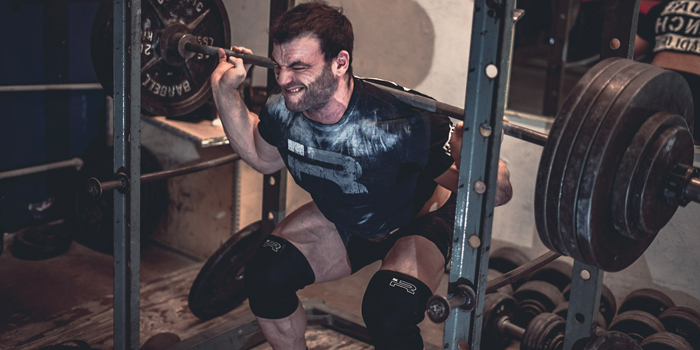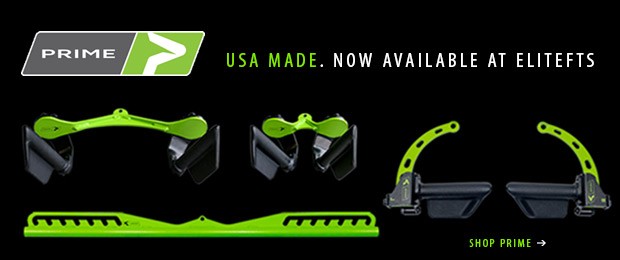
In case you’re not familiar with this article series, over the past year, I’ve been writing about how I apply bodybuilding training methods to help improve my powerlifting performance. Recently, I’ve started trying the opposite approach, as well: using powerlifting to improve my physique. And it’s working, really well.
RECENT: Bodybuilding for the Powerlifter: Extra Workouts
For a long time, powerlifters were characterized as guys who were strong as hell and big as f*%! — but not in an aesthetic way. The stereotypical powerlifter might have 21-inch arms, but he also has 21% bodyfat. And as impressive as that is, most people are looking to stay a little leaner. Of course, lately, powerlifters have been moving in the other direction.
And while a few guys (including Dan Green, Larry Wheels, and yours truly) might incorporate quite a bit of bodybuilding work into their training, most of them are building these physiques on the squat, bench, deadlift, and maybe a handful of accessory movements. That might be surprising to the typical bodybuilding crowd raised on set after set of curls and front raises, but the results speak for themselves.
We’ll touch on the “why” in a little bit, but let’s start with the guy (or girl) who’s not a competitive powerlifter or bodybuilder. He wants to move big weights in the gym, look good naked, and still have fun training and eating. That guy needs the maximal effort method.
What is the Maximal Effort Method?
Put simply, the maximal effort (ME) method involves choosing one or two movements for either the upper or lower body, and slowly working up to a single, all-out top set on those movements. As popularized by Westside, the “traditional” ME method makes heavy use of accommodating resistance and specialty movements to target specific weaknesses on the competition lifts (squat, bench, and deadlift). On each movement, you work up to either a 1RM or 3RM, so the total volume of these sessions is typically pretty low — although you still do perform many sets in the process. Lifters stick with one set of movements for 2-4 week waves, and then move on to different movements.
The combination of high intensity, moderate volume training, coupled with frequent exercise rotation, has a wide variety of benefits. So it’s applicable to a wide variety of contexts, not just in training for powerlifting, but also for strongman and outside the world of strength sports, as well. There are several popular bodybuilding programs that make use of the ME method, too. In my opinion, though, many of those bodybuilding programs fall short. Like most cookie-cutter programs, they end up becoming a laundry list of exercises, which really undermines one of the biggest strengths of the ME method: it changes frequently.
So, the rest of this article will explain how to use the ME method for bodybuilding — not give you a mindless series of boxes to check off. By understanding how best to adjust the method to fit your goals, you can apply it much more effectively, and enjoy long-term success.
Max Effort Bodybuilding
Performing the max effort method like this is fantastic for developing maximal strength. But if your goals are broader than that (i.e., you want to be strong and look good), training for maximal strength isn’t always the best choice. Instead, you should train for balance.
When it comes to the max effort method, here’s what that means.
1. Choose different movements. Tools like accommodating resistance, partial or extended ROM movements are great for strengthening weak points in a lift, but they’re not always the best for developing weak body parts. For example, if your quads are lagging, then box squats probably aren’t your best bet. Instead, you might try high bar squats using a very narrow stance.
Here are some examples of other max effort exercises you might use to help target various common aesthetic weaknesses:
- Lower quad (teardrop): front squat, narrow-stance high bar squat with toes out, hack squat (rarely)
- Shoulder width: behind the neck press, seated pin press in rack
- Upper chest: incline bench, wide grip tempo bench press, bench press with dumbbells (use rarely)
- Back width: wide grip partial deadlift
- Arms: close grip bench press with chains and elbows out, close grip weighted dips, close grip pin press
You’re not limited to these movements, of course, but I do recommend that you tend to stick with barbell movements performed through a full range of motion.
2. Increase the rep range. Sets of 1-3 are ideal for developing strength, but — unless you’re performing lots and lots of sets — they’re not ideal for aesthetics. Instead, try sticking to sets of 5-8 for your max effort work. The slightly high rep range will require the use of slightly lower weights, but that’s exactly how we find the balance you need to address your goals.
3. Work the muscles, not the movement. In powerlifting, your goal is to move a weight from point A to point B as efficiently as possible. In bodybuilding, your goal is to work your muscles as efficiently as possible. Ultimately, that comes down to controlling the weight, not just moving it. Oftentimes guys use tempo reps (for example, taking 3 seconds to lower the weight and 3 seconds to raise it), but it’s more important that you deliberately engage the muscles you’re trying to work. This basically comes down to the broscience of the mind-muscle connection, and although that’s a highly debated subject, I think you’ll find that there’s a huge difference between squatting a weight as fast as you can, and squatting a weight while focusing on the stretch and contraction of your quads.
A Sample ME Session for Developing Lower-Body Size
These particular movements are directed at someone who’s looking to gain size primarily in the hamstrings — a muscle that can be quite frustrating to get to grow. If you’re targeting quads instead, for example, you’d want to choose different movements, but the general ideas would remain the same.
1. ME Movement: Stiff-Leg Deficit Deadlift
Choose a deficit height that allows you to touch the bar to the floor without rounding your lower back (this will be determined by hamstring flexibility). I suggest you use tempo reps here, with a 2-second concentric and 4-second eccentric movement, and don’t touch the bar on the floor between reps. Work up to a maximal set of 6.
2. Supplementary Movement: Leg Press
Get your feet high up on the platform, so that your toes are hanging off, and really try to use your hamstrings to control the weight as you lower it. Use the maximum range of motion possible for your body. As you lift the weight, try to relax the toes and push through the heel, which will encourage use of the posterior chain. 4-5 sets of 5-8 reps. Use the heaviest weight that allows you to complete all sets.
3. Accessory 1: Reverse Hyperextension
You’re not doing these in the normal way. Check out this article for a full explanation. 3 sets of 10-12 using strict form.
4. Accessory 2: Hamstring Curl
Any hamstring curl is fine, although I prefer the seated variation, as it helps to minimize use of the lower back. 2-3 sets of 20+ reps.
5. Abs
Choose any movement and perform 3 sets of max reps.
This is a short, brutal session, but it’s virtually guaranteed to turn your hamstrings into ham hocks. That said, it’s important to note that this is one session that still needs to be incorporated into a weekly micro cycle and into the context of your long-term plan. I’ll explain more about how to do that in future articles.
Don’t Forget About Specialization
One last caveat for y’all: remember, this series is directed at lifters that want to get big and strong. If you’re only concerned about one of those, then this probably isn’t the best method for you. You’re more likely better off with the traditional ME method for strength alone, and with a higher-volume program with more variety for size alone.
That’s why you don’t see any pro bodybuilders or powerlifters training like this (at least, not leading up to a show or a meet). To get to that level, at some point, you must specialize.
On the other hand, if you’re not at that level yet, you’re probably better off not specializing. Instead, try to build as broad a base as possible, so that you can build on top of it for a long, long time. And if that’s your goal, then the max effort method for bodybuilding might be the perfect choice.











Thanks for any guidance you may be able to give!
Ryan